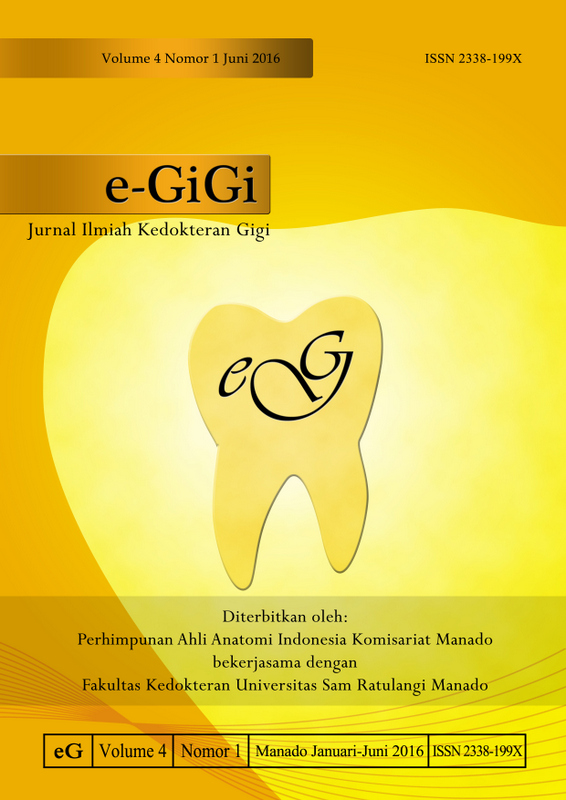Uji pelepasan ion nikel dan kromium pada beberapa braket stainless steel yang direndam di air laut
DOI:
https://doi.org/10.35790/eg.4.1.2016.11062Abstract
Abstract: Orthodontics is the branch of dentistry that studies about how to prevent, protect, and care of malocclusion involving teeth, as well as skeletal and soft tissues of dentofacial region. Fixed orthodontic appliance is one of the means used to achieve the treatment goal. The use of orthodontic bracket is one of the main components in fixed orthodontic treatment which serves to deliver the required force on the teeth. This study aimed to determine the amount of Cr and Ni ions released from the stainless steel bracket (brand A, B, and C) immersed in sea water. This was a laboratory experimental study with a pre-experimental and nonequivalent control group designs. Samples were assayed using UV-Vis spectroscopy to determine the release of the metals: nickel and chromium. The samples consisted of 4 kinds of brand bracket immersed in sea water for 48 hours at a temperature of 37ºC. The results showed that the release of nickel and chromium ions in sea water varied in each sample. In sample A, the release of nickel 0.096 ppm and of chromium 0.202 ppm. In sample B, the release of nickel 0.154 ppm and of chromium 0.027 and. In sample C, the release of nickel 0,066 ppm and of chromium 0,019 ppm. The release of chromium in each sample was higher than the release of nickel. The results showed that there was no particular pattern of the released ions. This might be due to the different composition of the stainless steel brackets depending on the terms of each manufacturer.
Keywords: bracket stainless steel, nickel and chromium, UV-Vis spectroscopy, seawater
Abstrak: Ortodonsia adalah cabang dari ilmu kedokteran gigi yang mempelajari tentang cara mencegah, melindungi, dan merawat maloklusi yang melibatkan gigi geligi, skeletal, dan jaringan lunak regio dentofasial. Alat ortodontik cekat merupakan salah satu cara yang digunakan untuk mencapai tujuan perawatan ontodontik. Penggunaan braket ortodonti merupakan salah satu komponen utama dalam perawatan ortodonti cekat yang berfungsi untuk menghantarkan gaya yang diperlukan pada gigi. Penelitian ini bertujuan untuk mengetahui besarnya ion Cr dan Ni yang terlepas pada braket stainless steel merek A, B, dan C yang direndam dalam air laut. Jenis penelitian yang digunakan ialah eksperimental laboratorik dengan rancangan pra eksperimental serta desain penelitian nonequivalent control group. Sampel diuji menggunakan spektroskopi UV-Vis untuk mengetahui pelepasan logam nikel dan cromium. Sampel terdiri dari 4 macam merek braket direndam dalam air laut selama 48 jam pada suhu 37ºC. Hasil penelitian menunjukkan terdapat pelepasan logam nikel dan kromium dalam air laut yang bervariasi di tiap sampel. Sampel A memiliki pelepasan nikel 0,096 ppm dan kromium 0,202 ppm; sampel B memiliki pelepasan nikel 0,154 ppm dan kromium 0,027; sampel C memiliki pelepasan nikel 0,066 ppm dan kromium 0,019 ppm. Pelepasan kromium pada tiap sampel lebih tinggi dibandingkan dengan pelepasan nikel. Hasil penelitian tidak menunjukan pola tertentu. Hal ini dapat disebabkan karena komposisi yang berbeda-beda dari braket stainless steel tergantung ketentuan masing-masing pembuatnya.
Kata kunci: braket stainless steel, nikel dan cromium, spektroskopi UV-Vis, air laut
Downloads
How to Cite
Issue
Section
License
COPYRIGHT
Authors who publish with this journal agree to the following terms:
Authors hold their copyright and grant this journal the privilege of first publication, with the work simultaneously licensed under a Creative Commons Attribution License that permits others to impart the work with an acknowledgment of the work's origin and initial publication by this journal.
Authors can enter into separate or additional contractual arrangements for the non-exclusive distribution of the journal's published version of the work (for example, post it to an institutional repository or publish it in a book), with an acknowledgment of its underlying publication in this journal.
Authors are permitted and encouraged to post their work online (for example, in institutional repositories or on their website) as it can lead to productive exchanges, as well as earlier and greater citation of the published work (See The Effect of Open Access).






